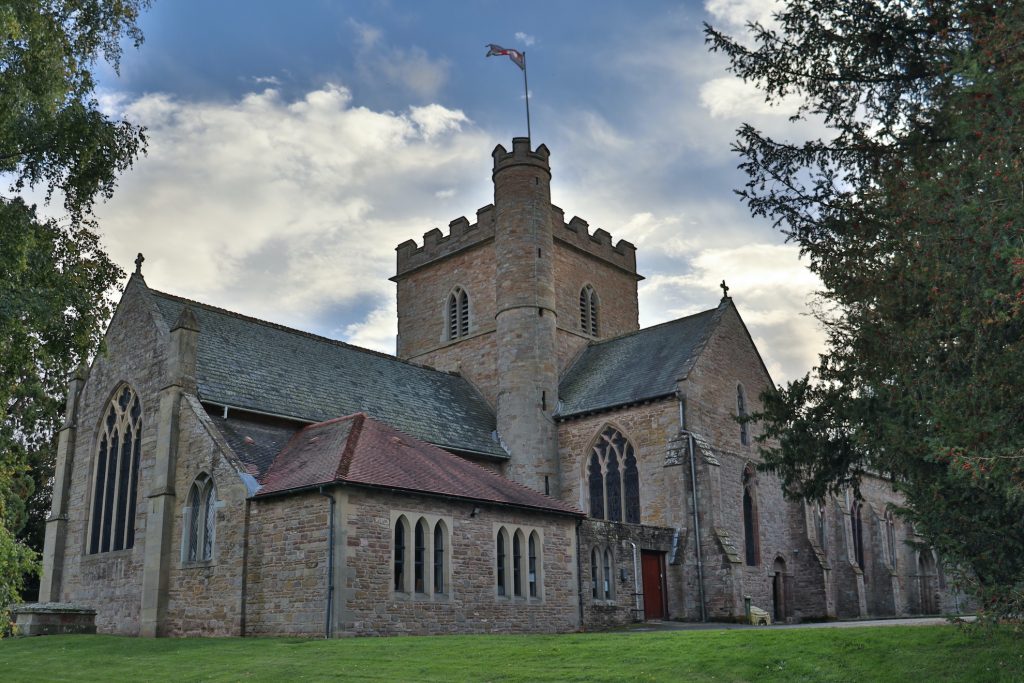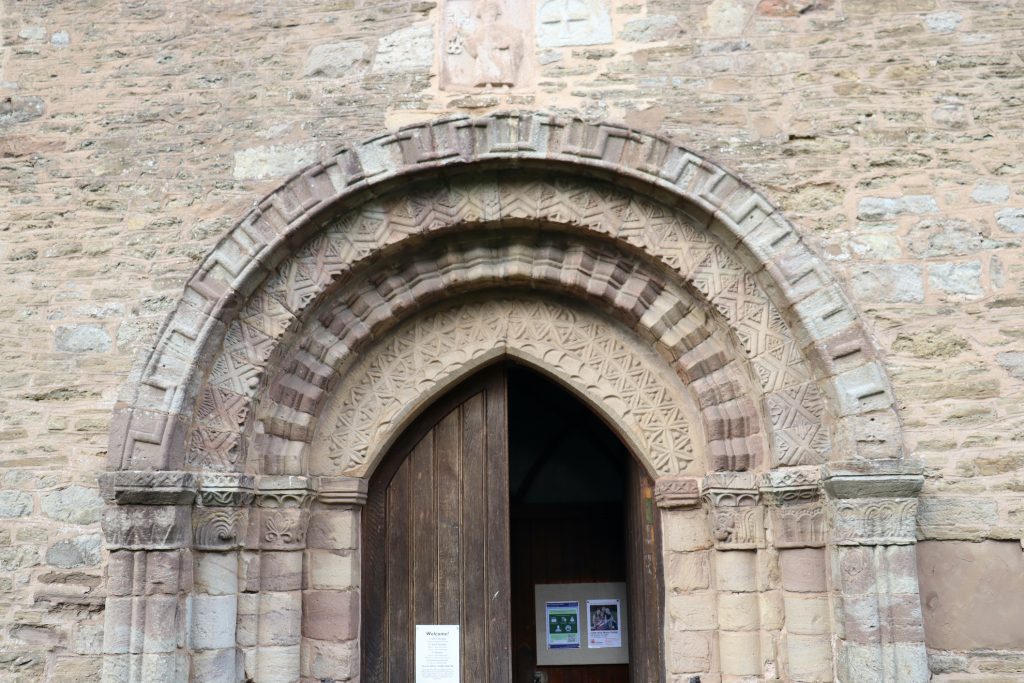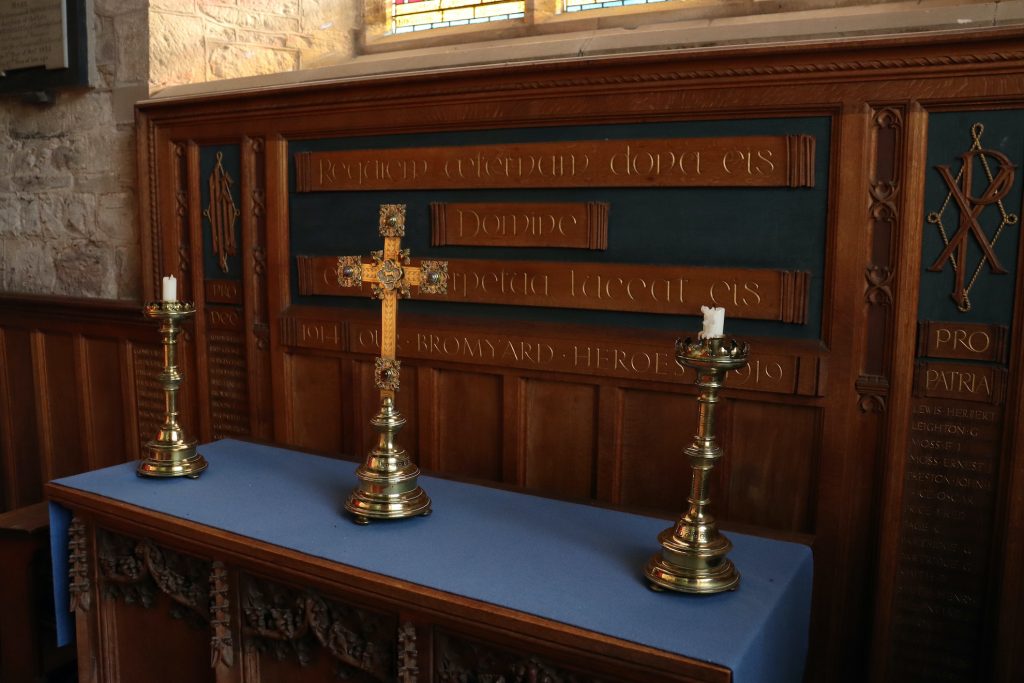
A Little History…
Bromyard was once an important ecclesiastical centre, with St Peter’s founded on the site of an earlier Anglo-Saxon church. Early records show there was a minster on the site around 840AD. However few traces of this remain: notably a carving of St Peter holding the keys to heaven and a consecration stone in a circle, above the south door through which you will have entered the church. Both of these are thought to have come from the earlier Saxon church. Otherwise the building you see today dates back to the late 12th Century.
Our Church records are some of the earliest in the country and were started in 1538 at the instigation of King Henry VIII. The churchyard was closed in 1915 since when burials have been in the town cemetery.

The main entrance, the south door, is of Norman origin, as is the door opposite, on the north wall, best appreciated from the outside.
1 Font and West Window
Near to the south door, the font is Norman and believed to have been installed when the present church was built.
Moving towards the centre of the church (the nave), look left. In the recently repaired west wall there was originally a doorway in the centre with a musicians’ gallery over it. In its place today is a stained glass window dedicated to St Cecilia, the patron saint of music. This is known as The Musicians’ Window and is full of famous local people.
2 The Avenbury Knight
Continue forward towards the north aisle which was added early in the 13th century. In the corner you will find the Avenbury Knight, a 13th century stone effigy originally from St Mary’s Church at Avenbury, a hamlet one mile to the south of Bromyard. St Mary’s is one of the oldest churches in England but it was closed in 1931 and is now a partial ruin.
Nearby is the Bromyard Bushel. This cast iron bowl was made in 1670 for measuring grain. Once used as a water butt in a private garden, it was next employed as a fireside log basket and finally donated to the church in 1936.
3 On this part of the West Wall you will see a copy of Deacon’s Synchronological Chart, a pictorial and written description of universal history with maps of the world’s great empires drawn by Professor Edward Hull and first published in 1890. About seven metres long, the chart depicts the biblical history of mankind from Adam and Eve through to Queen Victoria.
4 North Transept
Turn right and go down the north aisle and through the red curtains. Facing you is the oldest window in the church (pre-1300), although the stained glass itself is from the late 1800s. The window is dedicated to the Rev’d. William Cooke, vicar of St Peter’s between 1834 and 1855, and depicts Christ’s command to “Feed my Sheep”, his promise “I go to prepare a place for you” and the proclamation “He is Risen”.
Retrace your steps into the nave and turn left, passing the pulpit. Bromyard church had, at one time, a three deck pulpit. The present pulpit was made in about 1883 using wood from the original.
5 Chancel
Turn left into the long Chancel. This was extended in the 14th Century.
6 Organ
The Organ was built by J W Walker in 1839. It originally comprised 16 stops and two manuals and was located in a raised gallery at the west end, since demolished. It was moved to its present location in 1875 when two extra stops were added. Further modifications have taken place and in 1978 a new console, a swell mixture and great trumpet were added. It has recently been completely restored, thanks to the generosity of many townspeople.
7 At the east end, the High Altar fittings cover and conceal a fine wooden Communion Table made in the 16th Century, moved from Hereford Cathedral around 1805.

8 Chapel of Remembrance
Head back towards the nave and turn left into the side chapel. This is often called ‘The Lady Chapel’ but as it has never been dedicated to the Virgin Mary that description is incorrect.
At the end of the chapel is Bromyard’s town’s official War Memorial inscribed with the names of local soldiers who were killed in the between 1914 and 1919. The chapel was completed as you see it today and dedicated on 10th August 1919, just eight months after The Armistice. The Bromyard News and Record reported the service as follows:
A Word Picture:
“We gave our lives that this dear earth might be a sweeter and happier world; give yours to the consummation of our sacrifice. Give freely and joyously (as we gave ourselves) of your love and time and thought. Cherish and protect our loved ones, our wives, our sisters and our little ones. They are a precious legacy we bequeath you. Do your share as we did ours and our souls shall rest in everlasting peace. We look to you: do not forget.”
As you walked around the church you may have noticed recesses in the walls. These all date from the 14th Century and may once have held coffins or effigies of important people. Similarly, on the exterior south wall there are another two recesses.
9 The bells
In 1472 the Bishop of Hereford granted forgiveness for sins provided the sinner repented and made payment to help restore the church and belfry at Bromyard after it was damaged by lightning. Repairs were carried out and in 1553 five “great bells whereof the least is 32 inches the second 35 inches the third 40 inches the fourth is 45 inches and the fifth is 50 inches broad at the mouth” were listed in the inventory. Today there are eight bells which are rung regularly by volunteer ringers and visiting teams throughout the year.
More information about St Peter’s Church can be found at the Local History Society, Sherford Street, Bromyard and in various books, some of which are available from the local bookshop, the local History Society or at the town library.